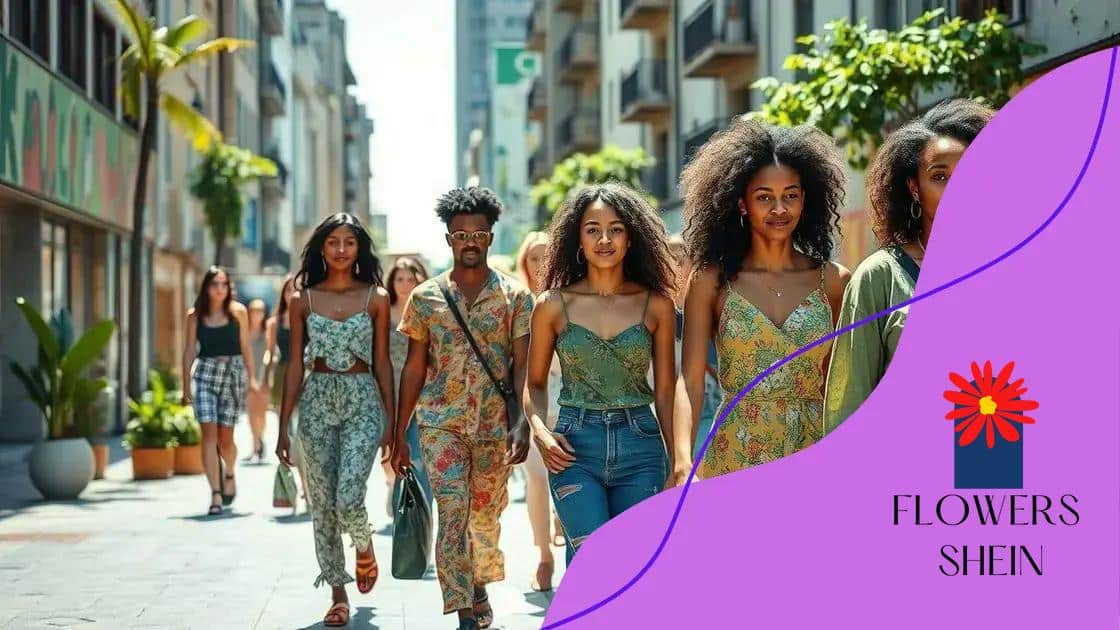Shein’s collaboration with eco-conscious designers

Shein’s collaboration with eco-conscious designers focuses on sustainability through using recycled materials, educating consumers, and enhancing transparency in its supply chain, despite facing challenges like supply chain complexities and consumer price expectations.
Shein’s collaboration with eco-conscious designers marks a significant turn in the fashion industry, embracing sustainability like never before. Are you curious about what this means for your wardrobe and the environment? Let’s dive in.
The rise of eco-conscious fashion
The rise of eco-conscious fashion reflects a growing awareness among consumers about the environmental impact of their purchasing decisions. As more people become informed about the fashion industry’s ecological footprint, brands are increasingly embracing sustainability.
Why Eco-Conscious Fashion Matters
Eco-conscious fashion is vital for several reasons. It reduces waste, conserves natural resources, and promotes ethical labor practices. By opting for sustainable options, consumers can play a part in protecting our planet.
- Minimizes textile waste through recycling initiatives.
- Uses organic materials to reduce pesticide use.
- Supports fair wages for workers in developing countries.
Moreover, the shift towards sustainability is not just a trend; it is a necessary evolution. As new collections launch, they often highlight environmentally friendly materials and production methods. Brands like Shein are now collaborating with designers who prioritize sustainability, showcasing the potential for change.
Consumer Demand for Sustainable Options
Consumers today are more vocal about their preferences. They seek brands that align with their values. This demand has led many fashion companies to rethink their strategies and invest in eco-friendly practices. For instance, shoppers often prefer products made from recycled materials.
The rise of social media also plays a significant role in this movement. Influencers and environmental activists are spreading the message of sustainability, prompting followers to make better choices. As a result, brands are responding by amplifying their sustainable messages in marketing campaigns.
With the prevalence of fast fashion, it is critical to encourage a culture where eco-conscious fashion is the norm rather than the exception. Initiatives like clothing swaps and second-hand marketplaces are becoming popular as consumers seek alternatives to buy new clothing.
How Shein partners with sustainable designers
How Shein partners with sustainable designers reveals a significant shift in the fast fashion industry. By collaborating with designers who prioritize eco-friendly practices, Shein aims to minimize its environmental footprint.
Collaboration with Innovative Designers
Shein has tapped into a network of innovative designers dedicated to sustainability. These partnerships often focus on using organic materials and promoting recycling within the fashion supply chain. Working together, they create collections that meet consumer demand for stylish yet sustainable choices.
- Utilization of recycled fabrics in new collections.
- Promotion of biodegradable packaging for products.
- Support for local artisans and ethical labor practices.
Through these partnerships, Shein can offer trendy clothing while highlighting the importance of sustainability. This approach encourages consumers to make environmentally friendly choices without sacrificing style.
Awareness and Education
In tandem with these collaborations, Shein also focuses on raising awareness about sustainability in fashion. As part of their initiatives, they run campaigns that educate consumers on eco-friendly practices, such as proper garment care and the benefits of buying sustainable clothing.
By sharing stories of the designers they collaborate with, Shein connects consumers to the people behind the products. This strategy not only builds brand loyalty but also emphasizes a collective effort towards a more sustainable future.
Furthermore, these partnerships serve as a model for the entire fashion industry, showing that it is possible to blend style with sustainability. As markets evolve, it becomes increasingly clear that a commitment to eco-friendly practices is essential.
Impact on consumer choices and habits

The impact on consumer choices and habits is a crucial aspect of the growing eco-conscious fashion movement. As consumers become more aware of sustainability, their buying decisions shift significantly.
Shifts in Purchasing Behavior
More people now prioritize eco-friendly products over fast fashion. This change reflects in how consumers evaluate brands. They often ask questions about a product’s material and production process before making a purchase. Sustainable options are no longer an afterthought; they are becoming the preferred choice.
- Increased interest in second-hand and thrift shopping.
- Willingness to pay more for sustainable items.
- Preference for brands with transparent supply chains.
As consumers become more informed, they tend to support brands that align with their values. For instance, many shoppers now research the environmental impact of their clothing choices and turn to brands committed to sustainability. This shift is reshaping the entire fashion industry.
Influence of Social Media
Social media also plays a significant role in consumer habits. Influencers and environmental advocates highlight the importance of sustainable fashion, reaching a wide audience. Their messages empower consumers to make more responsible choices.
Through platforms like Instagram and TikTok, sustainable fashion trends spread quickly. Consumers share their eco-friendly purchases, creating a community that values sustainability. This grassroots support encourages brands to adopt greener practices.
Finally, the impact on consumer choices is not just a trend; it represents a significant cultural shift. As sustainability becomes ingrained in shopping habits, brands like Shein must adapt to meet the new expectations of their customers. Engaging in eco-friendly practices is now essential for businesses that wish to thrive.
Challenges in sustainable collaborations
The challenges in sustainable collaborations are essential to understand as the fashion industry evolves. While many brands strive for eco-friendly practices, they often face hurdles in implementing these changes effectively.
Supply Chain Complexities
One significant challenge is the complexity of the supply chain. Achieving sustainability requires transparency at every level, from raw materials to production. Many brands find it difficult to trace their materials back to the source, which can lead to potential greenwashing.
- Difficulty in verifying the sustainability of sourced materials.
- Limited availability of eco-friendly suppliers.
- High costs associated with sustainable sourcing.
These complexities can hinder efforts to create truly sustainable products. Brands may struggle to find partners who share their commitment to sustainability or who can provide the required materials at a reasonable price.
Consumer Expectations
Another challenge is balancing consumer expectations with sustainable practices. Consumers often expect low prices and quick delivery, which can conflict with the principles of sustainability. Fast fashion models, based on rapid production cycles, are hard to change without losing customer satisfaction.
To address these expectations, brands must educate consumers about the value of sustainable fashion. This includes emphasizing the benefits of quality over quantity. Shoppers need to understand that sustainable choices often come with a higher price tag due to ethical sourcing and production processes.
Despite these challenges, many brands are actively seeking solutions, including innovative partnerships and sustainable technology. As the demand for eco-friendly options grows, overcoming these challenges becomes vital for long-term success in the fashion industry.
Future of eco-friendly initiatives at Shein
The future of eco-friendly initiatives at Shein is a topic of great interest as the fashion industry continues to evolve. With rising awareness about climate change, brands are under pressure to adopt sustainable practices. Shein is no exception, and its commitment to the environment is becoming increasingly evident.
Commitment to Sustainability
Shein is investing in sustainable initiatives to enhance its brand image and appeal to eco-conscious consumers. The company aims to reduce its carbon footprint through various strategies, including using recycled materials in their collections. This shift not only addresses consumer demand but also aligns with global sustainability goals.
- Exploration of innovative, eco-friendly fabrics.
- Implementation of carbon offset programs.
- Increased transparency in supply chain practices.
By focusing on these areas, Shein is paving the way for future growth while aligning with the growing trend toward sustainability in fashion.
Engaging Consumers
Moreover, engaging consumers is a critical part of Shein’s strategy. They plan to educate their audience on sustainable fashion through campaigns and initiatives. By informing customers about the benefits of eco-friendly practices, Shein can foster a sense of community among its shoppers.
Interactive platforms and social media campaigns will allow customers to share their sustainable fashion choices. This engagement not only builds brand loyalty but also creates a supportive network focused on eco-consciousness.
As Shein continues to innovate and adapt, the future of its eco-friendly initiatives looks promising. The brand is positioned to lead the way in transforming the fast fashion landscape, making sustainability a core aspect of its identity.
FAQ – Frequently Asked Questions about Shein’s Eco-Friendly Initiatives
What steps is Shein taking towards sustainability?
Shein is focusing on using recycled materials, collaborating with sustainable designers, and increasing transparency in its supply chain.
How does Shein engage consumers in eco-friendly practices?
Shein educates consumers about sustainable fashion through campaigns and encourages them to share their eco-friendly choices on social media.
What challenges does Shein face in implementing sustainable practices?
Shein contends with supply chain complexities, verifying sustainable materials, and balancing consumer expectations for low prices.
What is the future outlook for Shein’s eco-friendly initiatives?
The future looks promising as Shein continues to innovate and adapt its strategies to lead in sustainable fashion, making eco-friendly options accessible to a broader audience.





